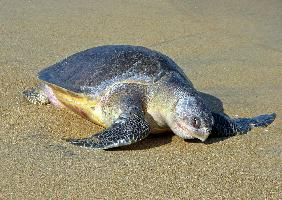
Greutăți și măsuri
| Lungime | de la 58 la 70 cm |
|---|---|
| Greutate | 50 kg |
Starea de conservare
| Amenințat |
Descrierea animalului
The Olive Ridley sea turtle (Lepidochelys olivacea), named for the olive color of its heart-shaped shell or carapace, is one of the smallest species within the sea turtle family. Adult Olive Ridleys typically weigh between 80 to 110 pounds (approximately 36 to 50 kilograms) and measure around 2 to 2.5 feet (about 60 to 70 centimeters) in shell length, showcasing a relatively diminutive stature compared to some of their larger sea turtle relatives.These turtles are widely recognized for their unique mass nesting behavior known as "arribada," a Spanish term meaning "arrival." During an arribada, thousands of female turtles congregate and come ashore to the same beach where they were born, laying eggs in the sand in a remarkable synchronized nesting event. This phenomenon primarily occurs in a few select locations around the world, including the coasts of Mexico, Costa Rica, and India, making it a spectacular, yet vulnerable, natural event.
The Olive Ridley's diet is omnivorous, consisting of a wide variety of food sources including jellyfish, small invertebrates, algae, snails, crabs, and fish. Their foraging habits contribute to the health of marine ecosystems, as they help control jellyfish populations and recycle nutrients.
Despite their widespread distribution across the tropical regions of the South Atlantic, Pacific, and Indian Oceans, Olive Ridley sea turtles face significant threats from human activities. These threats include accidental capture in fishing gear, known as bycatch; direct harvesting of turtles and their eggs for consumption; loss of nesting beach habitats due to coastal development; and pollution, especially plastic debris that turtles may mistake for jellyfish or other prey.
Conservation efforts for the Olive Ridley sea turtle are multifaceted, involving legal protection, beach management practices to protect nesting sites, and initiatives to reduce bycatch. Many countries have enacted laws to protect these turtles, and international agreements like the Convention on International Trade in Endangered Species of Wild Fauna and Flora (CITES) regulate the trade of Olive Ridley turtles and their products to prevent exploitation. Moreover, community-based conservation programs that involve local populations in the protection of nesting beaches have shown success in increasing hatchling survival rates.
The Olive Ridley sea turtle plays a crucial role in marine ecosystems and is a symbol of the interconnectedness of oceanic life. Their survival is not only important for maintaining biological diversity but also for the cultural and natural heritage of the regions they inhabit. As such, their conservation is a global concern that requires international cooperation and the commitment of local communities to ensure these ancient mariners continue to grace our oceans for generations to come.
Harta răspândirii

Animale similare
Fotografii noi cu animale
Top 10 animale
- Dolphin gull (Leucophaeus scoresbii)
- Diana monkey (Cercopithecus diana)
- Moustached guenon (Cercopithecus cephus)
- Stone loach (Barbatula barbatula)
- Greek tortoise (Testudo graeca)
- Galápagos tortoise (Geochelone nigra complex)
- Japanese macaque (Macaca fuscata)
- Russian tortoise (Testudo horsfieldii)
- Common flying dragon (Draco volans)
- Galápagos penguin (Spheniscus mendiculus)

